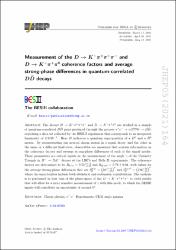Measurement of the D -> K-pi(+)pi(+)pi(-) and D -> K-pi(+)pi(0) coherence factors and average strong-phase differences in quantum-correlated D(D)over-bar decays

View/
Access
info:eu-repo/semantics/openAccessAttribution-NoDerivs 3.0 United Stateshttp://creativecommons.org/licenses/by-nd/3.0/us/Date
2021Metadata
Show full item recordCitation
Ablikim, M (Ablikim, M.)[ 1 ] ; Achasov, MN (Achasov, M. N.)[ 10, 80 ] ; Adlarson, P (Adlarson, P.)[ 73 ] ; Ahmed, S (Ahmed, S.)[ 15 ] ; Albrecht, M (Albrecht, M. ). . . (2021). Measurement of the D -> K-pi(+)pi(+)pi(-) and D -> K-pi(+)pi(0) coherence factors and average strong-phase differences in quantum-correlated D(D)over-bar decays. Journal of High Energy Physics, 164(05), 0–45. https://doi.org/10.1007/JHEP05(2021)164Abstract
The decays D -> K-+pi(+)pi(-) and D -> K-pi(+)pi(0) are studied in a sample of quantum-correlated D (D) over bar pair produced through the process e(+)e(-) -> psi(3770) -> D (D) over bar, exploiting a data set collected by the BESIII experiment that corresponds to an integrated luminosity of 2.93 fb(-1). Here D indicates a quantum superposition of a D-0 and a D-0 meson. By reconstructing one neutral charm meson in a signal decay, and the other in the same or a different final state, observables are measured that contain information on the coherence factors and average strong-phase differences of each of the signal modes. These parameters are critical inputs in the measurement of the angle gamma of the Unitarity Triangle in B- -> DK- decays at the LHCb and Belle II experiments. The coherence factors are determined to be R-K3 pi = 0.52(-0.10)(+0.12) and R-K pi pi 0 = 0.78 +/- 0.04, with values for the average strong-phase differences that are delta(K3 pi)(D) = (167(-19)(+31))degrees and delta(K pi pi 0)(D) = (196)degrees, where the uncertainties include both statistical and systematic contributions. The analysis is re-performed in four bins of the phase-space of the D -> K-pi(+)pi(+)pi(-) to yield results that will allow for a more sensitive measurement of gamma with this mode, to which the BESIII inputs will contribute an uncertainty of around 6 degrees.
Source
Journal of High Energy PhysicsVolume
164Issue
5Collections
The following license files are associated with this item:


















